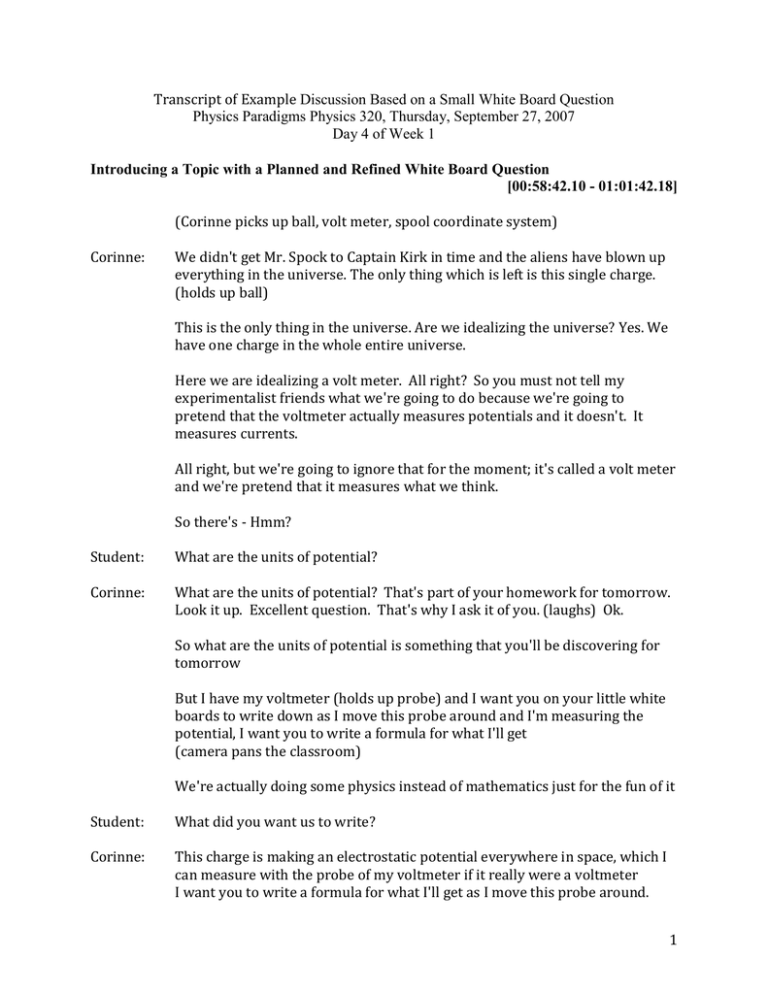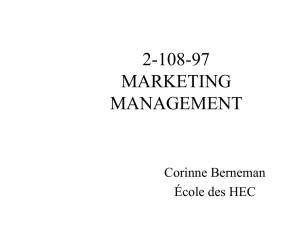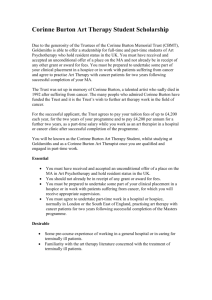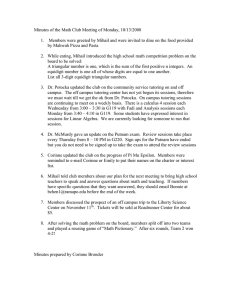Transcript of Example Discussion Based on a Small White Board... Physics Paradigms Physics 320, Thursday, September 27, 2007
advertisement

Transcript of Example Discussion Based on a Small White Board Question Physics Paradigms Physics 320, Thursday, September 27, 2007 Day 4 of Week 1 Introducing a Topic with a Planned and Refined White Board Question [00:58:42.10 - 01:01:42.18] (Corinne picks up ball, volt meter, spool coordinate system) Corinne: We didn't get Mr. Spock to Captain Kirk in time and the aliens have blown up everything in the universe. The only thing which is left is this single charge. (holds up ball) This is the only thing in the universe. Are we idealizing the universe? Yes. We have one charge in the whole entire universe. Here we are idealizing a volt meter. All right? So you must not tell my experimentalist friends what we're going to do because we're going to pretend that the voltmeter actually measures potentials and it doesn't. It measures currents. All right, but we're going to ignore that for the moment; it's called a volt meter and we're pretend that it measures what we think. So there's - Hmm? Student: What are the units of potential? Corinne: What are the units of potential? That's part of your homework for tomorrow. Look it up. Excellent question. That's why I ask it of you. (laughs) Ok. So what are the units of potential is something that you'll be discovering for tomorrow But I have my voltmeter (holds up probe) and I want you on your little white boards to write down as I move this probe around and I'm measuring the potential, I want you to write a formula for what I'll get (camera pans the classroom) We're actually doing some physics instead of mathematics just for the fun of it Student: What did you want us to write? Corinne: This charge is making an electrostatic potential everywhere in space, which I can measure with the probe of my voltmeter if it really were a voltmeter I want you to write a formula for what I'll get as I move this probe around. 1 And write big enough that I can harass you by looking at your answers. (camera pans the room, focuses on student writing: Student: Do you want the potential or the electric field? Corinne: Potential Student: In terms of the electric field? Corinne: Excuse me? Student: In terms of the electric field? Corinne: Have I mentioned electric field yet? Student: You mentioned charge Corinne: I mentioned charge so write it in terms of charge. S: (?) Corinne: I don't care because I'm going to hold up a lot of answers so you can all tell me something. Picking Up Small White Boards [01:01:42.18] – [01:03:10.03] (walks around room picking up white boards) Corinne: (laughs) even if you do want to rethink it (places white boards on blackboard ledge with writing toward board so answers can not be seen) (collects more boards) Corinne: Question mark All right. One of the questions that came up. I'm collecting samples of each, oh, I'm collecting an example If I walk past you it's because I've already collected one that looks like yours. Discussing the First Two Small White Boards Corinne: [01:03:10.03] – [01:04:21.03] Ok. One of the questions was what should you write the potential in terms of? And some of you started talking about electric fields so here we have one which says that the potential is the integral of the electric field something, this looks like a line integral to me. 2 (holds up white board so all can see) the line integral of the electric field but since I haven't told you anything about what the electric field IS, this is probably not the answer to the question that I was looking for Here we have actually that the potential is the derivative of the electric field (holds up other white board) and some of you may or may not be familiar with this funny del sign (holds up both white boards) so we have a vote here, it's either the integral of the electric field or it's the derivative of the electric field so we're going to abandon this question until maybe even next paradigm but if Liz will record those two possibilities, we will have that vote later (puts both boards down on one of the tables) Now we have an interesting, whoops, just smudged that one (turns over several boards) Ok. Asking for A Comparison of Responses [01:04:21.03]- [01:05:42.12] 3 So we have a selection of answers here that I want to discuss a little bit (camera moves across them:) So we have two people, three people saying that there's an r squared in the denominator and two people saying there's an r in the denominator We have one person claiming that the potential is a vector (points to board) and another person claiming that the potential is a scalar (points to adjacent board) We have two people, three people, claiming there's a single Q in the numerator and we have two people claiming that there are two Q's or perhaps a Q squared in the numerator What do you have to say about these choices? Acknowledging a Common Response [01:05:42.12]- [01:07:04.19] 4 Student: Isn't the one on the far left the force? between two point charges? Corinne: Isn't the one on the far left the force? (holds up white board k (Q squared)/(r squared) what force? A point charge on another point charge? What do you think of that answer? yeah (?) Yes What people tend to lodge in their head is the formula for force and not the formula for potential Student: Corinne: Student: Corinne: and so when I ask this question, out come little pieces of the force law as opposed to the potential law. All right. So this is the most typically memorized Of course if you talk about the force, you have to have two objects in the universe (walks over to a student and puts hand on his shoulder) excuse me (name), if I want to have a force, I have to be pushing on somebody All right. I can't exert a force if I'm the only thing in the universe. So if there's only one charge in the universe (holds up ball) then we can't be talking about forces yet, which is why we're going to be talking about forces later on when I allow there to be two charges in the universe. All right. So we have only one charge in the universe The two charges, either a Q squared or a Q one and a Q two, comes from thinking about forces Potentials, there's just one charge 5 (holds up ball) So there's only one factor of Q there. Responding to a Student Question Student: Corinne: Student: Corinne: (student raises hand) Yes Isn't there something about integrating from zero to infinity? Isn't there something about integrating from zero to infinity? Integrating what? The potential. No. integrating the electric field from zero to infinity (goes over and holds up board with V = integral E dot ds yes there is but since we don't know what the electric field is, we can't use that fact; yes there is such a thing Using a White Board to Clarify a Student’s Thinking Student: Corinne: Student: [01:07:04.19] -[01:07:35.01] [01:07:35.01] - [01:09:36.07] way I think about it is to relate the electric potential to the gravitational potential because they're pretty much the same thing, the force equation is the same, so you do like force over, force times the distance? I mean that's work Write me down your equation so I can hold it up (writes on white board: W = F d) And then (writes V = K QyQd /r2 from 0 to d) Corinne: ok (reaches for white board) (takes board, moves away, moves back, student adds dr to board) Corinne: Ok (name) is claiming that you can use the gravitational analog, and for some peculiar reason many students are much better at reasoning about the gravitational case than reasoning about the electrostatic case 6 and you are absolutely right, except for an overall constant that has units in it, and a very important, physically important sign, all of the mathematics for gravitational fields is the same as the mathematics for electrostatic fields so if you can do it for a gravitational field and that makes sense to you, use that analogy. Let it help you! All right. So (holds up white board for all to see) (Name)'s claim is work is force times distance. All right. And then the potential is the integral of the force times the distance but I think that's a variant of this (holds up white board with V = E ds since if there's only one thing in the universe we can't yet be talking about forces, so there's good reasoning and good memory there going on but not what we need for this problem. [01:09:36.07] Yeah: Considering the Difference Between Potential and Potential Energy [01:09:36.07]- [01:11:20.09] Student: You asked for the potential and not energy Corinne: I asked for potential and not energy! Ah! and so, do you want to work with this? (Corinne retrieved and held up the small white board they had just been discussing with W = Fd and V = K Q1Qd/r2 dr ) Student: No because that's energy. Corinne: Yeah, this is energy All right? So this is potential energy as opposed to potential and there's a difference between potential energy and potential Yes. What difference is there? Student: Charge, the unit of a coulomb Corinne: Hmm? Unit of a coulomb. Say more! Student: The potential energy is the potential multiplied by the charge, coulomb Student: like if you had like a point charge, a test charge, in the vicinity of your main charge in the center (Corinne picks up ball that represents charge) 7 Corinne: Ok. So here's my main charge in the center and if I have another charge in the universe (picks up small white ball) then what? Student: Then you can calculate the potential energy between the two of them Corinne: Ok. Write down on some white board there the formula you're thinking about. Student: Well it's pretty close to what you Student2: It is what you said Corinne: Pretty close to what? Student: Isn't that what he had written down Corinne: Ok. so he has potential energy and what do you want to do with this? (Corinne held up the white board with V = K Q1Qd/r2 from 0 to d) Student: That's what New Student: Oh ah, you get rid of the second charge I think if that's energy, ah, that's (?) Corinne: Yes, so the force requires both charges to be in there, right? But in the end, so this will give you a calculation for the energy and at the end of the day if you divide by the second charge (points to symbol) or if you just divided by the second charge before you did the calculation yes Redirecting the Conversation Student: Corinne: Student: Corinne; [01:11:20.09]-[01:12:49;19] I was thinking about the power is equal to the current times the voltage and using that as an analogy Oh we're going to go to the power, ok, we're getting pretty far astray if we're headed to power I want to go back to these formulas I mean as far as the units of Matt's r squared, I was getting at because power is joules per sec and current is coulombs per sec, right? yeah, now we've got currents and everything let's go back, I 8 What you're trying to do is build a wonderful web of connected ideas in your head. You have a wonderful web of connected ideas in your head and I'm just trying to take one piece of it now So, let's go back to here (holds up ball) I want a formula in terms of the charges because that's what I gave you, no currents, no powers, no forces, no electric fields There's one charge in the universe and what we know is the charge on the charge (holds up ball and points to it) If that's all we know and we're trying to find the potential (picks up probe of voltmeter), I want something in terms of the charge We've got some examples here (points to white boards along ledge) We decided it couldn't be this one because it's got a Q squared in it (moves white board away from the rest) we decided it couldn't be this one because it's got a Q one Q two in it. (moves second board away from rest) Eliminating One Option [01:12:44:19] - 01:13:08.19] So now we're down to three choices What do you have to say about these three choices? 9 Student: The potential is a number so the vector one is out. Corinne: The potential is a number. (picks up board with vector notation and moves it away from the rest) Forces are vectors, electric fields are vectors, potentials are scalars My voltmeter is a pretty good voltmeter; it only reads a number; there is no arrow associated with it. Exploring an Unexpected Student Difficulty [01:13:08.19- [01:14:49.15] All right. So now we have a choice K or 1 over four pi epsilon naught as the constants, that's just a question of what system of units you're using. We will indeed be using the system of units where k is one over four pi epsilon naught so these two are identical in that sense. All right. So one over r squared or one over r Students: One over r Corinne: One over r, why? 10 Student: Because the potential is equal to the integral of the electric field over some distance so that's basically saying that the electric field, which is k Q over r squared times a distance r and r's canceled and you're left with k Q over r Corinne: I liked everything you said until you said the 'r's cancel' Student: Oh, sorry (laughter) Student: units Corinne: You said really beautiful things until you said it was the integral, and then you said the r's cancel if you're integrating Student: I meant after you integrate over a certain distance, the r is just the distance between so Corinne: You integrate something with an r squared in the denominator dr, you don't get to cancel the r's, you have to do the integral of r to the minus two (writes on board) the integral of r to the minus two is r to the minus one which it is but it's not because you cancelled the r's Student: Seems that way Corinne: But absolutely, one of these is the integral of the other and that's what we've been discussing One of these is the force or the electric field, both go like one over r squared, you integrate that, you get a potential and that gives you the one over r; So this is the potential Considering the Meaning of the Symbols [01:14:49.15] - [01:15:25.12] Now, what do we mean physically by the r here? Student: Radius Corinne: Radius Of the charge? (holds up ball) Student: How far away you test the charge Student: The distance from the charge 11 Student: The distance between the center of the charge Corinne: Hmm? between the center of what? Student: The charge and your observation point Corinne: Where's my observation point? Student: Whereever you put your probe Corinne: Ah. the distance between here (ball) and here (probe). All right. The distance between here and here. It's a distance. Using a Small White Board to Clarify a Student’s Question [01:15:25.12]- [01:17:14.02] Student: r minus r naught? Corinne: What about r minus r naught? Student: The distance between there and there Corinne: Write me something on your white board. I don't know what r minus r naught means. Ah. Ok! Corinne: Student: He's trying to write a magnitude of r minus r naught. So where is r and where is r naught? r naught is at the origin Corinne: Where is the origin? Student: (that)(points to coordinate system) Corinne: Ok. So I'm going to put this charge at the origin. Imagine it's in the center. All right. All right. And then? Student: The r is wherever you're thinking about at the moment, wherever that is Corinne: ok. Corinne: All right. If I put the charge at the origin, then what does that tell you about this? Students: r naught is zero 12 Corinne: Then it's just zero. What kind of a zero? It's a zero vector All right. So the zero vector minus r prime is just the vector from the origin to here So yes indeed, if I put this charge at the origin, then this r here is just the distance from here to here, the distance from here to here. Considering a More Complex Case Corinne: [01:17:14.02] - [01:18:50.11] What happens if I choose not to put this at the origin? (picks up ball and moves away from coordinate system) Student: (?) Corinnne: Yes, what I mean here is always the distance whether or not I happen to choose my origin to be at the center of the charge. (holds up ball and probe) Now if I have only one charge in the whole universe I would be really stupid not to put the origin where the charge is. (student laughs) Corinne: (laughs), ok. that would be really stupid so always put the origin someplace nice. All right. (picks up basketball) But as soon as I let the universe be more complicated so that there are two charges in the universe, I can't put them both at the origin, because they're separated I can put one at the origin maybe All right but as soon as I have two charges in the universe it's not so simple to say that this r (points to small white board) represents the distance between the origin and this point (picks up voltmeter probe) It represents something else. So now imagine that the second one (carries basketball to student to hold). Thank you. Ok so now we have two charges in the universe. All right. And now we have my potential meter. Let's look at just the potential due to this one but now I can't put it at the origin Corinne: So how do I talk about the distance between here (ball) and here (voltmeter probe)? How do I write it down 13 Considering a Student’s Spontaneous Use of a Small White Board [01:18:50.11] - Student: Magnitude of the difference between the vectors Corinne: Magnitude of the difference between the vectors (F student holds up white board to show) (Could have one at the origin) I could have one at the origin (F continues to hold up whiteboard) (?) All right. so you want me, ah (takes white board offered by student) You're going to make me work really hard for this answer Student: Corinne. Student: Corinne: Corinne: Corinne: (holds up white board so all can see)(x axis with charge at origin) So if you're really clever, you can put one at the origin and you can put the other one along the x axis (picks up coordinate system) Right? So then you can just use a scalar distance there (points to board) But do I have to put my probe also on the x axis somewhere between them? Student: Well I Corinne: What if I want to measure up here? (holds probe up high) Student: If you're working in a three dimensional space, it creates a potential around itself. so if you out from it at any radius in 3-D, you get the same potential. Corinne: Right. If I go out anywhere around this one the same radius, I get the same potential. Absolutely. But as I go probing around here and I'm getting the same potential from this one, I'm not staying the same radius from that one So all I want is the mathematics of how I describe the distance between here (probe) and here (ball on table). Student: the magnitude of the distance (?) 14 Corinne: S: (?) Corinne: Corinne: Exactly. It's the Star Trek example. All right which is what (Name) was trying to write down here and the only quibble I really have with you is "these are vectors" (takes board over to student and points at board) (write vectors on the bottom?) Ok? so what I have to do is say "here's the origin" (points to coordinate system) there's a position vector from here to here (points to ball); there's a position vector from here to here (points to origin, hold up and points to probe); and if I want the distance between these two places, I take the difference between those two position vectors and I take the magnitude thereof and it looks like this (points to blackboard) That's why we played Star Trek and as we get more and more charges in the universe and get up to the complexity of something that's actually happening in the laboratory, we're going to need to be using an expression like this (points to blackboard) (to student) keep your board for Friday Ok. I need a break. Five minutes. 15



